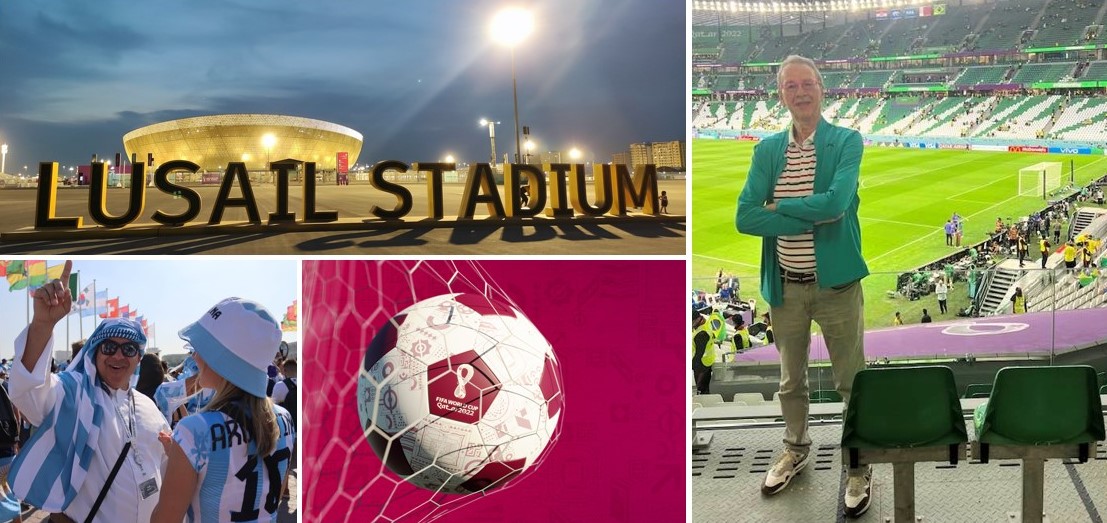By Colin Cohen
Hong Kong, 26 January 2023: It is several weeks since I boarded my Qatar Airways flight out of Doha to Brisbane for a festive break Down Under. Time enough to reflect on my trip to the World Cup, where the off-field experience was just as brilliant as the football.
1. When less is more
At face value, the idea of a nation such as Qatar hosting the World Cup is absurd. A tiny peninsular in the Arabian Gulf, it is just 11,586 square kilometres – smaller than the Falkland Islands – and is dwarfed by neighbour Saudi Arabia, which is 185 times bigger. But this made life much easier for me and thousands of other fans. At the last World Cup in Russia, it required planes, trains and automobiles, plus multiple hotel bookings, to attend 15 matches in four different cities. This time, I went to 27 games, frequently watching two a day, making full use of Qatar’s fantastic public transport network, and all from my rented apartment base just outside the capital, Doha. Perhaps this is what legendary Dutch coach Rinus Michels meant by “total football”.
2. No booze is good news
Some fans were aghast at the last-minute decision to outlaw beer sales at matches. Clarification is required here: booze was banned in most parts of the stadium but was available in copious quantities in the hospitality suites. Double standards, I hear you cry, and you have a point. However, the arrangement made for a far more enjoyable – and safe – match-day outing. I’ve been to many major tournaments and seen some alarming scenes in which excessive alcohol consumption has usually been the key factor. In Qatar, there was none of this. A sobering experience all around.
3. Hard-earned rewards
Much was made pre-tournament of the toils of the migrant construction workers who built Qatar’s impressive football stadiums and infrastructure. Given that non-Qataris comprise about 88% of the population, I had chance to chat with many imported employees from all industries – construction, transport, F&B and even the police (officers were on secondment from various countries, including Turkey, Pakistan, Egypt and Sudan). Their message was clear and consistent: yes, their work was often hard, but they were there out of choice and earned far more than in their native country. While acknowledging the construction fatalities, as the host nation did during the tournament, it is unfair to paint Qatar as unique in this respect. Migrant labourers are among the most vulnerable people anywhere on the planet, including Hong Kong, where our laws are stacked against them. Some perspective is required.
4. A kaleidoscope of colours
The beating heart of any World Cup is the fans. Noisy, exuberant, enthusiastic and bonded by a love of football, the estimated 1.2 million visitors who descended on Qatar turned a sandy outcrop in the Arabian Gulf into a month-long party. Many congregated at FIFA’s Fan Festival, located at Al Bidda Park in the centre of Doha, where they could watch all 64 matches on big screens, visit sponsor booths, buy World Cup memorabilia and – yes – drink beer. In short, a nightly reminder that while football has grown into a multi-billion-dollar global business behemoth, simple love of “the beautiful game” – a phrase popularised by the late, great Brazilian maestro Pele – is its bedrock. You can’t put a price on passion.
5. Under starter’s orders
One of the World Cup’s rest days allowed me to attend camel racing, which has a long and distinguished history in Qatar. The sport turned professional in 1972 and meetings are held each Friday between October and February at Al Shahaniya, a huge oval track next to a camel mini-city where hundreds of the thoroughbreds are stabled. You can watch from the stands or, as my hosts insisted, drive your car alongside the leaders on a road next to the track, cheering them on. It was great fun. The best part? On the back of each camel is a toddler-sized robot jockey, kitted out in silks, remote controlled by its trainer. A case of ancient meeting modern. Don’t ask if I backed a winner, though, betting there is illegal.
6. Welcoming the world
Qatar sees the World Cup as just the start of its tourism explosion. The country welcomed some 730,000 international visitors in the first half of 2022. It is aiming for six million a year by 2030. The government estimates around 80% of the world’s population lives within a six-hour flight. Around 150 new hotels were built ahead of the tournament and they expect to stay busy in the years to come. Sports and pastimes (between matches, I enjoyed three rounds of golf), mega-events, cultural attractions and, of course, shopping will be the pillars of Qatar’s tourism push. Would I return? Definitely!
7. Your cultural correspondent
I spent a pleasant few hours at the National Museum of Qatar, its 11 galleries revealing the nation’s fascinating history in a series of displays showcasing exhibits, antiques, artefacts and films. At its core is the magnificent palace that once belonged Sheikh Abdullah bin Jassim Al Thani, Qatar’s revered former ruler. It was his family home and once Qatar’s seat of government. On another day I took in the Museum of Islamic Art, housed in a spectacular waterfront building designed by I.M. Pei. It contains a stunning collection of masterpieces curated from all parts of the globe. Both museums offered a truly memorable experience. And you thought I was only in Qatar for the football.
8. Grand designs
Qatar built eight stadiums for the World Cup. I visited seven of them and saw many of my matches, including the final, at the 88,000-capacity Lusail Stadium. A spectacular venue, designed to reflect an Islamic hand-crafted bowl, it rises out of the desert sand on the northern fringes of Doha. Equally impressive is the 69,000-seat Al Bayt Stadium in Al Khor City, 35km north of the capital, its striking design resembling a bayt al sha’ar (tent) of the nation’s nomadic tribes. If these two venues have their roots in history, the iconic Stadium 974 just east of Doha is all about the future. Constructed entirely from shipping containers and modular steel, it is now being dismantled and is due to be rebuilt in a needy nation as a gift from Qatar. Useless trivia time: 974 is Qatar’s international dialling code and the exact number of shipping containers used in construction.
9. Train of thought
When, in 2010, Qatar won the World Cup hosting rights, its rail network was non-existent. Nine years later, the first phase of the Doha Metro was opened. Come tournament time, this three-line tube system spanning 37 stations across the capital and connecting five of the eight stadiums was the transport of choice for most fans. Like every supporter, I had a digital Hayya Card, effectively a mandatory fan ID document, which was needed (together with your match ticket) to enter a stadium. The card also granted free access to the country’s public transport network for the duration of the tournament. A ticket to ride, indeed.
10. And finally, the football
England did what England always do: played reasonably well and lost to the first half-decent team they faced (holders France). Qatar struggled gamely. Germany went home early (again). Portugal and Belgium were teams disunited. Brazil flattered to deceive. Morocco thrilled the Arab world with an unexpected run to the semi-finals. And Argentina, led by the ageless Lionel Messi, rose phoenix-like from the ashes of a shock opening defeat to Saudi Arabia to lift the trophy in a memorable final against France. I witnessed history being made. Roll on 2026 when Canada, the US and Mexico will co-host. I will be there.
Senior Partner in BC&C since 2004, Colin Cohen has vast experience in the highest levels of Hong Kong’s legal system. When not practising law, he spends considerable time following sport, being a keen Chelsea FC fan, MCC member and Formula 1 devotee, while BC&C has a proud history of supporting sporting initiatives at grassroots level. Colin can be contacted at colin@boasecohencollins.com.



